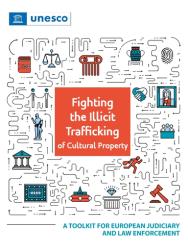
Learning on Culture in Emergencies
Culture is facing an increasing number of challenges and risks worldwide, including armed conflicts, disasters (both natural and human-induced), and climate change, which often reinforce each other.
These risks impact the whole culture sector and all types of cultural heritage, including built and natural, on land and underwater, museums and collections, living heritage, and the cultural and creative industries.
In this context, UNESCO supports its Member States to better prepare for and respond to emergencies affecting their culture, including through strengthening the national capacities.
UNESCO has developed tools, guidance, training materials and other resources, including interactive and online, tailored to emergency contexts in order to put in place adequate procedures and measures at the national and local levels to improve emergency preparedness for culture and Member States’ response capacity.
At the policy level, UNESCO helps:
- define the basic principles and critical actions to protect heritage and creativity in emergencies, and
- promote the integration of culture into overall disaster reduction and recovery frameworks, as well as the incorporation of emergency response into cultural policies.
At the operational level, UNESCO:
- produces practical tools to support cultural professionals and practitioners mitigate risks of built heritage, museums and movable heritage, living heritage, and the cultural and creative industries;
- supports the organization of capacity-buildings activities for cultural professionals and practitioners
Government officials
For Government officials to protect heritage and creativity in emergencies and promote the integration of culture into the overall disaster risk management and recovery frameworks, development strategies, as well as the incorporation of emergency preparedness and response protocols into cultural policies.

Cultural professionals and practitioners
For cultural professionals and practitioners, specialized in built or natural heritage, including site managers, museums and movable heritage, experts in the fight against illicit trafficking, intangible cultural heritage practitioners, and specialists in cultural economy and the cultural and creative industries.

Communities
For communities, including artists, youth and women, to be equipped with relevant knowledge and skills to engage in the safeguarding, protection and promotion of their cultural heritage as well as cultural and artistic creation.

Experts
For experts beyond the culture sector, including military and law enforcement personnel, civil protection, the judiciary, and disaster risk management experts.

The key tools in the field of World Heritage, Intangible Heritage, Creative Industries, and Cities
The key tools in the field of World Heritage, Intangible Heritage, Creative Industries, and Cities include:
- The Strategy for Risk Reduction at World Heritage Properties (2007).
- The Operational principles and modalities for safeguarding intangible cultural heritage in emergencies (2019).
- The Culture in crisis: policy guide for a resilient creative sector (2021).
- Disaster Resilience Scorecard for Cities: Cultural Heritage Addendum (2021).
- Defending creative voices: artists in emergencies, learning from the safety of journalists (2023).

The Guideline for Post-Disaster Needs Assessment of the Culture Sector
The Guideline for Post-Disaster Needs Assessment of the Culture Sector led by UNESCO is the internationally agreed methodology to assess the damage and loss of disasters and set the roadmap for response and recovery for culture.

Obtaining baseline data. Inventories, documentation, and digitization are key measures to establish baseline information and formulate preparedness, response, and recovery actions. For example, UNESCO has developed guidelines for the inventories of Intangible Cultural Heritage and Underwater Heritage.
Enhancing preventive measures. For example, through the Museum Outreach Programme, UNESCO has developed several tools to address the security and safety of museums and collections. ICCROM and UNESCO also cooperated for the RE-ORG Method as a practical tool to train professionals and mitigate collection risks.
Risk assessment is the first step to understand the vulnerability of the culture sector and [AV1] mitigate risks. In this regard, practical tools have been developed by UNESCO's technical partner ICCROM which should be adapted for different contexts.
Emergency Intervention This takes place after the breakout of the crisis. The tools for emergency evacuation and first aid (developed by UNESCO’s technical partner ICCROM) are of great value and have been widely used in the training of cultural professionals and first aiders worldwide.

Learning Tools
General Publications







